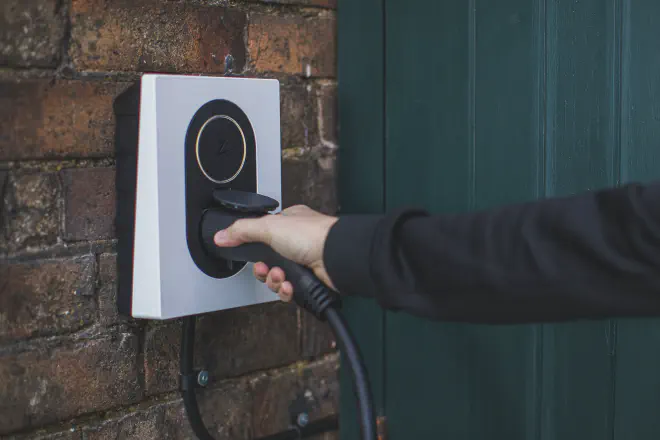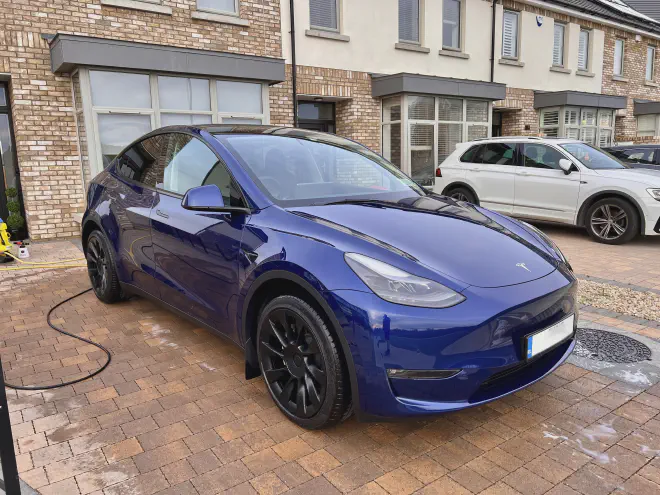Dipping My Toe in - My Introduction to EVs 🔋

Table of Contents
So it begins #
Since moving to our new house in 2021 we knew that eventually it would be easier to have two cars; the public transport is ok however not great and because we would be able to financially support two cars then why not take the easy road (pun intended)?
As someone who loves tech I thought I would take the opportunity to take the opportunity to look into EVs as up until that point I had never driven one.
After a quick test drive in both a VW Tiguan and then a VW id.4 for comparison I was convinced that EV was for me and had decided to go with the id.4 when the time eventually came.
Fast forward a few months and I took a test drive of the Skoda Enyaq and really enjoyed it in comparison to the id.4 and liked the interior a little more. When I then asked to put in an order I was told that the order books were closed and that they would give me a call in the future… not great but not unexpected with the global supply chain issues at the time.

Around the same time I took another drive in the id.4 and as they had just released their specs for the AWD version (Skoda only had the RWD variant) and so I put an order down for the GTX Max trim.

Unfortunately over the following 3 months my delivery date was pushed back multiple times and in the end it was pushed back over 8 months and even then it wasn’t confirmed and so I started looking into alternatives…
Ever thought of a Tesla? #
My views on Tesla up until that point were that they were expensive and didn’t have a great reputation for their build quality but the second opinion was based only on cars out of their original Fremont factory and not the Shanghai one which was now supplying cars for the Irish market.
Tesla are different in a lot of aspects to a lot of the “legacy” car brands in that their buying experience is completely online, you can browse the site just like you would Amazon, input your card details and make a reservation with a small, easy deposit.
Around the same time (January 2022) the options for the Irish market in Teslas were exclusively the Model 3 as neither of the more expensive Model S or X were available and the Model Y was not yet available in Europe however they were taking orders.
It seems a little strange now that I think of it that I ordered a car having never driven one or even seen one (that I know of) but given that the deposit was only €100 I thought it was harmless to do.
I was able to visit the Tesla service centre in Dublin a few days later and at least sit in a Model Y that they had there but it was an imported EU model which wasn’t able to be driven; at least it allowed me to sit in one and make sure it fits our size requirements.
A little over a month later, in the middle of every other car brand cutting features and delaying delivery I got my SMS to arrange delivery!

What is different about the Tesla supply chain? #
After I was able to order, pay for and take delivery in a very short amount of time it really amazed me.
Here we were, in the middle of a supply chain shortage when every other car which I could see was facing delays or certain features being unavailable and Tesla were able to still deliver, how was this?
From what I can tell there are really a couple of major changes to the way that Tesla, who are fundamentally still a tech company does their manufacturing compared to other manufacturers.
Vertical integration #
the combination in one firm of two or more stages of production normally operated by separate firms.
The first thing which makes Tesla quicker is that they can pivot around shortages due to their vertical integration.
Whereas other manufacturers will test, validate and then incorporate a given component into their cars and never change it until a model revision or refresh Tesla will instead construct new alternative parts from whatever is available.
Lets imagine that you have a certain processor to go in one of the components in the vehicle; in the old world you would select the model of that processor and you would rely on the validation performed to ensure your cars are all the same. This is fine if you can always get supply of that part however if you can’t then you are faced with delays to your whole manufacturing process.
From what I can tell Tesla don’t really have as much of a strict policy around single components and will swap in and out components as things become available whilst still maintaining the features of the car.
Mass production #
With most of the cars on the market selecting the model of the car is only the first step and next you need to pick which of the many “option packs” you want to include. Some of these packs are things which enable things which are purely software and some will mean extra hardware is installed in the car (e.g. faster charging or reverse cameras).
With Tesla you have very few choices to make:
- Model of the car (e.g. Model 3, Model Y)
- Trim (e.g. Standard Range, Long Range, Performance)
- Colour
- Wheel Size
- Interior colour (black or white)
Given the small number of options what it means is that unlike when I make my VW reservation and received a “build slot” for my car I was instead buying a place in the “queue” for my specific configuration. Tesla simply make a certain quantity of each SKU and ship them to their destination.
The car which I ended up receiving had probably already been made by the time I placed my order and somewhere between the port in Shanghai and the port in Ireland I was “matched” to it.
Do I regret my choice? #
I would be lying if I told you that it isn’t all sunshines and lollipops in the land of Elon, I don’t think I would chose differently if I were to do it all again though.
The issues I have with the car are mainly around things which Tesla believe (sometimes a little too ambitiously) that they can answer with software rather than the tried and tested hardware.
Some of these things such as rain sensors, radar and light sensors are things which probably help them with the vertical integration but sometimes it feels like them putting the cart before the horse when it comes to software development which isn’t quite there yet.